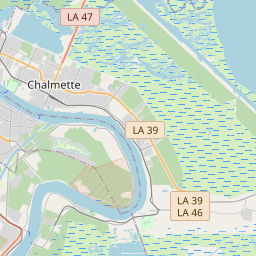In the Protestant Section
Historical marker location:
429 Basin Street, New Orleans, Louisiana
( Marker is on Basin Street.)
Marker installed: 1984







© OpenStreetMap contributors
Benjamin Henry Boneval Latrobe. Henry Sellon Boneval Latrobe
Loading...
Searching for other points of interest within 3 miles of this location.Hurricane Katrina, which struck Louisiana in 2005, was one of the deadliest and costliest hurricanes in U.S. history. The storm caused widespread destruction in New Orleans and other parts of the state, and its aftermath highlighted issues of poverty, race, and government response in the United States.
About Orleans Parish
Orleans Parish Timeline
Orleans Parish, located in the southeastern part of the state of Louisiana, has a rich and diverse history that stretches back for centuries. The area was originally inhabited by Native American tribes, including the Chitimacha and Choctaw peoples, who lived off the bountiful natural resources found in the marshy landscapes.
In 1682, the French explorer Robert Cavelier de La Salle claimed the Mississippi River and the surrounding area for France, including what is now Orleans Parish. The French began to establish settlements along the river, including New Orleans in 1718. The city quickly became an important hub for trade, thanks to its strategic location near the mouth of the Mississippi River.
In 1763, after the French and Indian War, France ceded the territory to Spain. However, the Spanish rule was short-lived, as France regained control of the territory in 1800 under the Treaty of San Ildefonso. Just three years later, in 1803, the Louisiana Purchase took place, with the United States acquiring Orleans Parish and the rest of the Louisiana Territory from France.
Under American rule, New Orleans continued to flourish as a center for trade, culture, and entertainment, attracting people from various backgrounds and ethnicities. The city became known for its vibrant music scene, including the birth of jazz in the early 20th century. However, Orleans Parish also faced its share of challenges, including devastating hurricanes and racial inequality during the civil rights era. Today, it remains a vibrant and dynamic part of Louisiana, with a unique blend of French, Spanish, and American influences.
In 1682, the French explorer Robert Cavelier de La Salle claimed the Mississippi River and the surrounding area for France, including what is now Orleans Parish. The French began to establish settlements along the river, including New Orleans in 1718. The city quickly became an important hub for trade, thanks to its strategic location near the mouth of the Mississippi River.
In 1763, after the French and Indian War, France ceded the territory to Spain. However, the Spanish rule was short-lived, as France regained control of the territory in 1800 under the Treaty of San Ildefonso. Just three years later, in 1803, the Louisiana Purchase took place, with the United States acquiring Orleans Parish and the rest of the Louisiana Territory from France.
Under American rule, New Orleans continued to flourish as a center for trade, culture, and entertainment, attracting people from various backgrounds and ethnicities. The city became known for its vibrant music scene, including the birth of jazz in the early 20th century. However, Orleans Parish also faced its share of challenges, including devastating hurricanes and racial inequality during the civil rights era. Today, it remains a vibrant and dynamic part of Louisiana, with a unique blend of French, Spanish, and American influences.
Orleans Parish Timeline
This timeline provides a glimpse into the major events and milestones that have shaped the history of Orleans Parish, Louisiana.
- 1699 - French explorers first claim the area that would later become Orleans Parish.
- 1718 - Jean-Baptiste Le Moyne de Bienville founds the city of New Orleans.
- 1763 - Orleans Parish becomes a Spanish territory following the Treaty of Paris.
- 1803 - The United States acquires Orleans Parish as part of the Louisiana Purchase.
- 1812 - Orleans Parish is admitted as the 18th state within the United States.
- 1835 - New Orleans becomes the largest city in the southern United States.
- 1862 - Orleans Parish falls under Union control during the American Civil War.
- 1874 - The Battle of Liberty Place takes place in New Orleans, reflecting ongoing political tensions in Orleans Parish.
- 1896 - Plessy v. Ferguson, a landmark U.S. Supreme Court decision, originates from a case in Orleans Parish.
- 1965 - Hurricane Betsy strikes New Orleans, causing significant damage and loss of life in Orleans Parish.
- 2005 - Hurricane Katrina devastates New Orleans and Orleans Parish, leading to widespread destruction and loss of life.